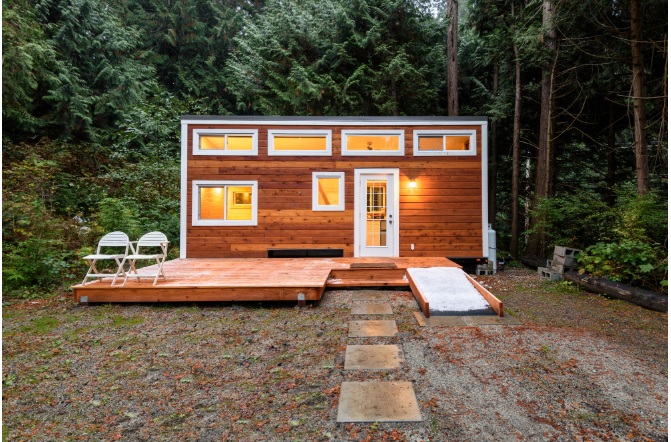
While some dream of mansions filled with indoor pools, personal theaters, and master bedrooms the size of an apartment, others go the opposite direction. Tiny homes and mobile homes have a particular appeal because of the financial freedom they bring, the philosophy of simple living, and highlighting experiences over things.
But what is the difference between tiny house vs mobile home, and which is more advantageous for your situation? Read on to learn the differences between these two homes and which is the best choice for you!
What Is a Tiny House?
It first helps to know what makes a house a tiny house. Most American homes are about 2,600 square feels, while the typical tiny house has square footage between 100 and 400 – most tiny house owners have the square footage of less than 400.
A tiny house can be rented or owned. You can also choose whether you want a home on wheels or one set on a foundation.
They can come in many different shapes and forms, as it’s up to the owner to decide whether they want to make one themselves from a kit, purchase one, or adopt one from a trailer.
What Is a Mobile Home?
Mobile homes are also called manufactured homes. This is because they’re built in factories, then placed on a trailer chassis that allows them to move. Most mobile homes are placed in mobile home parks or on leased land.
While the owner rents the space or leases the land, they own the mobile home itself. They can also place mobile homes on land they own, or land they’re buying under contract.
Because they’re considered personal property, they depreciate in value quickly, so it’s important to sell mobile homes fast if you’re ready to move!
Tiny House vs Mobile Home
Here are some factors to consider if you’re on the fence about purchasing a tiny house or mobile home.
Tiny House Cost
Cost is probably the biggest factor when it comes to deciding which home is right for you, and there are some extra fees to consider besides the initial price of the home.
The average price for a tiny house that’s either settled on foundations or fitted with wheels is $75,000. Some extra costs on top of that to consider are:
- Gas – Tiny houses use a combination of solar energy and gas for power. Most of them use a 10-gallon gas tank that needs to be resupplied every 1 to 2 months.
- Land – If they’re not on the road, tiny houses need a place to park during the day that you’ll need to rent or own.
- Towing – Even if your tiny house is fitted for a trailer, not all of them actually come with a trailer, and you’ll need to buy it separately.
Mobile Home Cost
Mobile homes are more affordable compared to tiny houses. A used mobile home can be as low as $25,000, while a new, upgraded model that can fit a family has an average cost of $60,000. Some of the features they include are full kitchens, a common area, and a sleeping area.
However, mobile homes also have several hidden costs:
- Gas – Mobile homes go through more gas than tiny houses because they’re heavier vehicles that take more power to move.
- Dump Station – Mobile homes need access to dump stations in order to empty your dark water tank and clean your septic system. They have an annual fee of about $250.
- Maintenance – Mobile homes that travel often have higher maintenance costs for oil changes, tires, transmission checks, and engine repairs.
Tiny House Environmental Impact
Tiny houses leave a very small carbon footprint. Besides natural gas to power the home, they also utilize solar panels and even wind power.
Because space is limited in tiny houses, owners don’t want trash building up. To combat this they compost and recycle, allowing the home to collect less food waste.
Lastly, many certified tiny house builders are conscious of the environment and use repurposed and recycled materials.
Mobile Home Environmental Impact
Many mobile homes weren’t built with the environment in mind and don’t use repurposed or recycled materials. Furthermore, since they’re solely reliant on gas they have a higher carbon footprint.
However, some newer mobile homes are built with eco-technology and are Energy Star certified, allowing them to reduce the amount of gas and propane used to power the home. Some may also include Energy Star certified appliances that reduce the amount of power used.
Tiny Home Structural Safety
More often, how safe a tiny home depends on who built it. Tiny homes on foundations that are built by certified builders are capable of being just as safe as normal homes; however, attached to wheels they can be compared to campers, as their size and weight are very similar. These obviously won’t be as safe during severe storms.
Mobile Home Structural Safety
Constructed since the ’50s, mobile homes were first known for their terrible insulation, weak walls, bad plumbing, and aluminum wiring. However, starting in the 80’s newer mobile homes are built with the same materials as site-built homes, with stricter building codes. This gives them the ability to withstand as much as site-built homes.
Living a Downsized Life
Choosing a tiny house vs mobile home comes down to your personal preferences and your financial situation. While they differ in how they’re made along with their cost, both retain the philosophy of financial freedom and simple living.
Keep browsing our sitefor the latest news in the real estate industry, and informative, quality nonprofit and government press releases!













